In Florida, a Purple Finch was recently spotted as far south as Sarasota, and Red-breasted Nuthatches were found at Cape Canaveral. And get this: A Pine Siskin was heard flying over Everglades National Park!
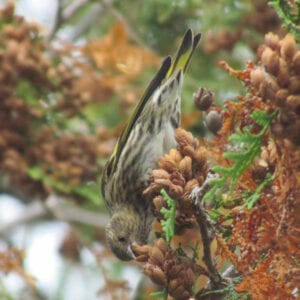
Pine Siskins, a “winter finch” from the North, surprised birders by showing up in Florida recently.
Meanwhile, Pine Siskins and Red-breasted Nuthatches were reported far, far to the north in the tiny community of Moosonee, on the shore of James Bay in northern Ontario. In fact, Red-breasted Nuthatches are being spotted this winter even farther north, in Yellowknife, Northwest Territories, where they are extremely rare in winter.
Perhaps most amazing of all, a Red-breasted Nuthatch was photographed in Iceland—that’s right, Iceland!—just a few days ago, the second-ever record of the species there!
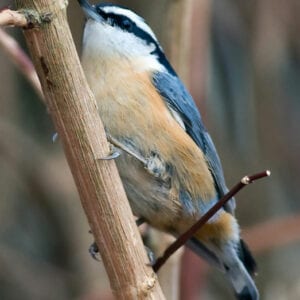
Iceland just saw its second-ever record of Red-breasted Nuthatch. Photo by Kirk Rogers
What’s wrong with this picture? Well, nothing, it’s just pretty darned exciting because these are signs of a major winter finch/northern bird irruption currently taking place across much of the continent.
Irruptive finches and species like Red-breasted Nuthatch breed across the vast Boreal Forest. Many of you may have been fortunate enough to have seen some at your feeders in late fall and early winter. In our neighborhood we were blessed with a large flock of Pine Siskins that spent weeks feeding in the tall northern white cedar on the edge of our neighbor’s driveway. We saw quite a large flock of Common Redpolls at the end of October at the Viles Arboretum in Augusta. Nearby, at the headquarters of the Natural Resources Council of Maine and, just blocks away, at the State House, a flock of about a dozen beautiful Pine Grosbeaks fed and softly chortled in the trees bearing dried but apparently still delicious, by bird standards, fruits.
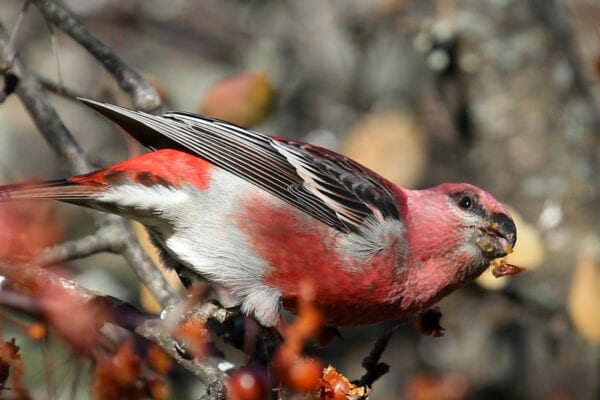
A flock Pine Grosbeaks made the rounds in Augusta, showing up in fruit trees near the State House and at the headquarters of the Natural Resources Council of Maine. Photo by David Small
We experienced Evening Grosbeak envy when Mom Wells hosted some of the bright yellow birds at her Damariscotta feeder earlier in the fall. Not to be outdone, our cousin’s husband photographed a migrating Purple Finch that landed on his boat 12 miles out to sea (which we wrote about in our Boothbay Register column). As for Red-breasted Nuthatches, they seem to be everywhere, making appearances in odd places as early as August as they started moving south in numbers.
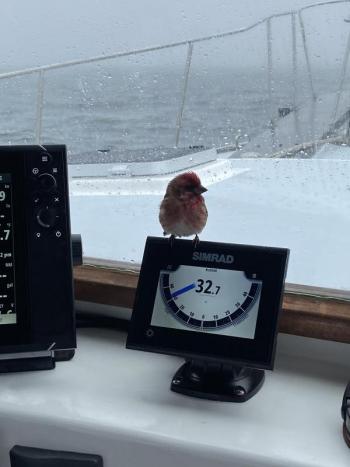
A Purple Finch hitched a ride on the author’s cousin’s husband’s boat 12 miles off the coast of Boothbay. Photo courtesy Sewall Maddox
In the same column in which we wrote about the boat-going Purple Finch, we wrote about the massive irruption of Boreal Forest-breeding birds, describing how these movements of large numbers of birds over vast distances do not happen every year. That’s different from the movements of most seasonal migrants, which move from their summer homes to their winter homes every year like clockwork. In fact, it is largely only birds of the Boreal Forest that seem to show these large-scale irruptions. This is, in part at least, because of the truly vast areas of intact habitat over which these species can breed during the summer. When there is a highly successful breeding season across the Boreal region, bird population numbers reach a high at the end of summer. If food in the Boreal then becomes scarce, then those huge numbers of birds begin moving south, looking for new sources of food—and providing us with lots of winter visitors to see.
We saw the largest numbers of some of the winter finch irruptive species—Pine Siskins, Common Redpolls, Purple Finches, Evening Grosbeaks—in the late fall and early winter. Since then, we’ve seen only a few siskins and redpolls. Other folks we know have had similar experiences. Pine Grosbeaks, on the other hand, peaked later in our area—in December.
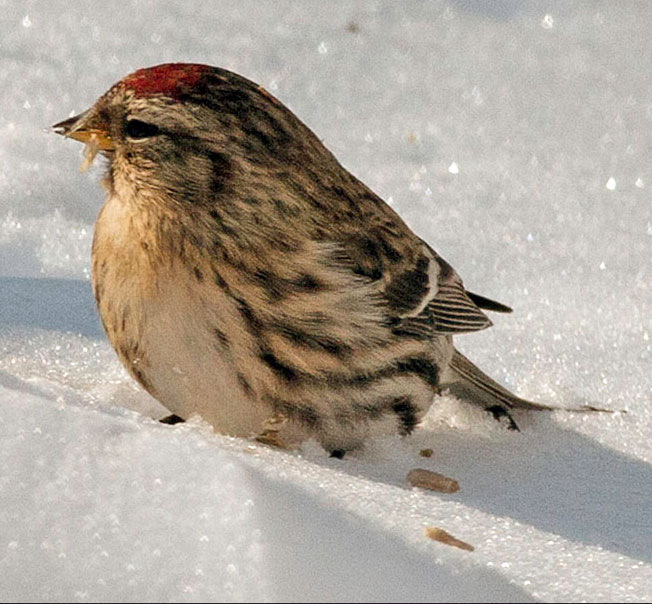
Common Redpoll by Kirk Rogers
This was enough to get us wondering where those irruptive birds we saw earlier in the season are now. To answer that question, we queried the trusty eBird database. It turns out that there are still scattered sightings of all of these species around Maine. But the total numbers seem to be less, and the overall number of locations where they are being seen is lower. Perhaps the only species bucking that trend is the Red-breasted Nuthatch, which is still being seen at a great many backyard feeders across the state, even ones that don’t regularly host them, like ours.
What eBird didn’t tell us was why some of these “snow birds” lived up to their name and zipped off to Florida while others went in completely in the opposite direction, to parts far to the north. We’ll chock that up to the many wonderful mysteries of nature.
—Jeff & Allison Wells











I have had redpolls at my feeder and have been hoping for evening grosbeaks. I will look for these other species now too although I live in Maine and it sounds like they are unpredictable here now. Thank you for this information.
We too are hoping for Evening Grosbeak but are glad we’ve seen their cousins, the Pines. Good birding!